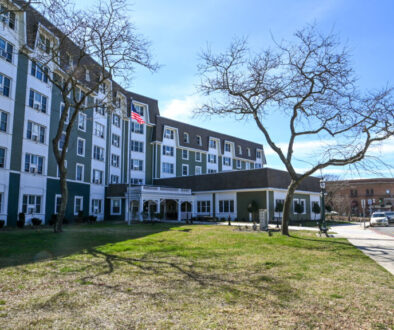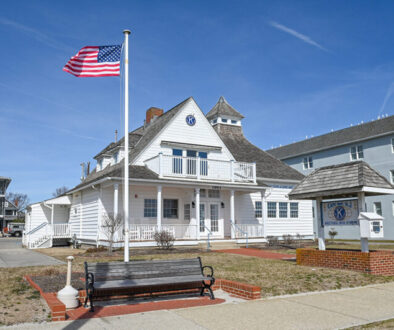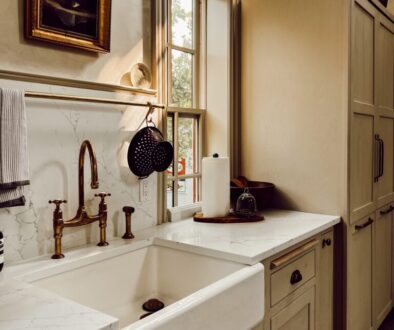Mad Scientists and Wandering Eagles

This is about a company that began with an ambition to improve the science of studying bird migratory habits and about a couple of people who worked it all out at a kitchen table. It’s about how it grew into a worldwide supplier of the tiniest little devices that follow not only birds, but mammals and sea creatures traveling from here to there as the seasons require.
All this is based right here in Cape May County.
Mike Lanzone and Casey Halverson head Cellular Tracking Technologies, a group of biologists, software writers and programmers, circuit board builders, and miraculous tools and machines housed in two glass hangar-like buildings at Cape May County Airport. They came to Cape May County in 2016 because they saw it as the best place to put their inventions and technologies to work.
Mike, Chief Executive Officer, is an ornithologist who was the Biotechnology and Biomonitoring Lab Coordinator at Powdermill Avian Research Center field station in Westmorland County, Pennsylvania. Among the lab’s projects was tracking the routes of Golden Eagles as they flew over the ridges of the Allegheny Mountains using updrafts to help them migrate to and from their seasonal homes near the Arctic Circle. Researchers wanted more details about eagles’ flight patterns and destinations that would teach them about the birds’ breeding behavior.

“We did not know how many golden eagles were in the east; we knew there were probably a few thousand—one of the main goals was to understand how they were using the ridge to fly,” Mike explains.
At that time the birds were equipped with satellite transmitters securely and painlessly strapped to their backs. The devices sent signals to earth-bound satellites that in turn sent the signals back to receivers at the lab, so researchers knew that the eagles were moving. But only intermittently could they tell where the travelers stopped, for how long, and what happened after they left the territory that satellite sensors could detect.
Mike had an idea: make a cellular transmitter because it can hold and send a lot more data over a cell network than a satellite setup can.
But how to make such a device? It had never been done. He began a search through technical literature and one day came upon an article in CNet News, a technical news website.
“How to Build Your Own Cellphone” was written by Casey, a self-described techie and tinkerer who was a network engineer in Seattle, Washington. Mike contacted him, and Casey replied: “I have a lot of bald eagles around my house, and I often wonder where they go. This sounds like a really cool project; I’ll help you with it.”
Thus began a marathon commuting partnership. Casey regularly flew between Seattle and Pittsburgh, then drove to Donegal, Pennsylvania where Mike lived with his wife Trish Miller—a fellow ornithologist who also worked at the Carnegie lab—and their two kids. The men set up operations on the kitchen table and began converting theory into practice, figuring out how to build little cellular transmitters that could record the far distances that eagles fly to their Arctic winter grounds. They’d go out to the nearby mountains, attach their tiny new transmitters to the birds, then watch on Google Earth the flight and resting patterns sent back in fine detail.


The old satellite systems showed where an eagle flew—which is not in a straight line—where and when it rested, until there was no way to receive the signal. But now, in a case containing the tiniest electronics imaginable, even without cell phone coverage beyond a point near the Arctic Circle, the little tracking devices on the eagle’s back still ticks away, recording and storing information after the unwitting traveler has found its seasonal home. As soon as the birds head back and reach the first available cell tower, the satellite recorder, which is programmed to detect that tower, begins to transmit. “Once we get down into the border between the U.S. and Canada, we get the cellular receiver and we just download months and months’ worth of data all at once to our servers,” explains Mike. And the eagle is not annoyed; the case—called a tag—is about 3% of the bird’s weight and attached in a way that does not obstruct any of its movements.
“It’s like an entire tiny smart phone on a bird,” says Casey. “We build a cellular network for receiving wildlife tags, like a base station to receive those signals. If you have thousands of base stations around the country, as that bird makes its migratory path from north to south, the device the bird carries pings off those stations on its journey, so we get a view: this bird went from Canada all the way down to Mexico, and this is the path.”
Instead of 8 to 12 flight locations sent by satellites, this invention can collect over one hundred times more information—and send it with a much lower energy requirement.


Scientists in this field have organized a collaboration called The MOTUS System, (MOTUS is a scientific term meaning a movement, or motion) of which CTT is a part. One scientist has one project, others have other projects, and they all collaborate, so that the same type of receivers are everywhere that migration patterns are being studied. If a bird in a certain study sends a signal to a station in another study, they will share the data. “It’s sort of a clearing house for all the signals a network has received,” explains Casey.
Researchers now know where a bird has been and for how long. And where it finally has settled for the rest of the year—which could be right here in Cape May.
Once they had perfected their technology, Mike and Casey began visiting scientific conferences to demonstrate their invention and the amount of data it could collect. People asked, “Where can we buy this?” Answer: “Well, you can’t. We make them on our kitchen table.”
Eventually, Trish ordered the operation off the table and out of the house. Mike and Casey created their company, Cellular Tracking Technologies, in 2007 and moved to a space in Donegal, then later to nearby Somerset, where they spent about four years.




They hired their first employee, Jason Benedict, to help manufacture their first product. He is still with the company.
Both kept their day jobs: Mike with the Carnegie Lab and Casey as a software engineer, flying back and forth from Seattle. They needed to, Casey notes. “Mike and I are not really rich people, and we just sort of bootstrapped from nothing. We spent a couple hundred bucks to get a business license and that kind of stuff, but for the most part we are self-funded. There are no investors; Mike and I had normal day jobs, so we had to work around that.”
“We did get a little bit of grant money; it wasn’t a whole lot, but enough to fund some aspects of it. But for the most part it was a lot of work with no pay,” adds Mike.
“These were scary times,” Casey recalls. “You gotta make sure the revenue’s coming in and you don’t always get a paycheck, so it wasn’t a gravy train.”
Mike finally plunged into the company full time in 2010. Casey’s last job in Seattle was unrewarding, but he was working remotely, allowing him free time to continue commuting. He finally quit that job and went full time to CTT in 2016, to become the company’s Chief Operating Officer.

It was time to move. Not only to a better location, but onward to even more intricate technology.
Casey: “I’d come over on a trip and Mike’s saying, ‘I’d like to really see where we’re taking this company; I want to really push the limit.’ And I’m listening. It was always my dream to eventually work for the company, but it seemed out of reach.”
Mike knew that they didn’t want to stay in Somerset, and he began developing a list of better places to locate, where he and his wife could both work. (She now operates the non-profit Conservation Science Global, which tracks those eagle flights.) He was close to determining that Cape May would be that place.
Casey had never heard of it. “Mike says it’s in New Jersey, so I’m thinking Newark Airport. I’d never ventured into South Jersey, but I looked it up and thought it kinda looks like a neat place,” he said. CTT had six employees then, and they all came to Cape May for a weekend. Everyone fell in love with it.
In addition to the benefits and pleasures that define it, Cape May is “a great place to set up a wildlife company,” Mike notes. “It’s a migration bottleneck,” as birders and nature lovers know well. What better place to experiment attaching tiny trackers to tiny birds—or big ones—and watching their migration journeys?


And there was the bonus of “great partners” doing related activities and research: Wetlands Institute; Cape May Point Science Center; Cape May Bird Observatory; and the Nature Center of Cape May.
Casey was living in the suburbs of Seattle. “I’m thinking [Cape May] is really special and a relatively safe place to raise a family. It was the small-town charm and the quality of life, and everything’s close by; I don’t have a two-hour commute; it is a great place in the summer; quiet in winter.” And there is the beach.
“I told my wife and kids; we’re all going to make the decision together.” Since then, others have moved here for jobs and location.
For years Cape May County has aspired to bring clean industry in and “…attract technology and innovation-based companies to the county and to its ‘Tech Hangars’ located at the Cape May Airport,” according to Cape May County Commissioner Will Morey, who has been CTT’s most active supporter. “They are a complement to the region’s tourism industry and bolster the County’s offerings of full-time, year-round, well-paying jobs that attract and keep educated young people in our community. Cellular Tracking Technologies . . . is a great example of the effectiveness of thoughtful public/ private partnerships.”
Together CTT and the county applied for grants to build headquarters at the county airport. In 2018, with 12 employees squeezed into a 1,000-square foot building, they designed a tech village. Ground was broken in 2019, and the first building opened in 2020. In 2021, running out of space yet again, CTT added two more units, for a total of almost 20,000 square feet.
As the company expanded, they hired people with related skills who had worked in Pennsylvania and, even though this area has a small tech-minded workforce, they found local people, sometimes recruiting from several job training services then training them in the specialized work required to manufacture their devices.


And then they went to Cape May County Technical High School. Casey serves on the school’s board and on that of Cape May County Special Services School. Both men are advisors helping to design a curriculum for a natural science program.
Lower Cape May Regional High School has what Mike describes as “a great 3D modeling CAD [Computer Aided Design] program.” From there they brought on a couple of interns who worked at CTT last summer. There was so much work to do that the students took on building actual products. “They were working on real things, and we depended on them,” says Mike. Interns are at the company from Lower Township High School, Cape May County Technical High School, and from Bucknell University.
“We’re demonstrating you can live here, and you can work in the tech industry. Sure, we’re not hiring a million people, but parents and others who would like to stay here or see their children remain nearby, are hoping that a budding tech industry here at the airport grows,” notes Mike.
Two years of the Covid pandemic and two years after, its effects still plague us, especially economic problems that started with supply chain delays. The CTT headquarters buildings were under construction, and the work continued, so in May of 2020, “We moved,” recalled Casey. “It was kind of insanity, a massive building, no one’s paying bills, we can’t get furniture or pay for it.” And there was the problem of the actual supply critical to CTT’s product: chips.
“A chip is not a commodity thing, like a chair,” Casey explains. “A chip is not only a technical thing you make but it’s got intellectual property attached to it. If you have a processor, say from Texas Instruments, no one else can make it. So, if they can’t make the chip that all our technology is designed around, what do you do? You just sit on your thumbs and watch the bank account drop.

“So, we had to get really innovative and redesign things over and over again to get around what chips we could get and make some crazy design decisions last minute. That could take two years, and sales were slumping.”
Mike goes on: “There are hundreds of components in a tracking device; every one of those chips does something different, and even if one of those chips is not available you have to find something [else] that does what it does, and fits in that footprint. So, it meant we had to redesign an entire board.”
Mike Lanzone
“There are hundreds of components in a tracking device; every one of those chips does something different, and even if one of those chips is not available you have to find something [else] that does what it does, and fits in that footprint.”
They looked at how a particular chip functions, then went to the engineering department, then to design, which then goes over to get laid out to make a new PCB or new components.
In other words, they invented and manufactured parts that would ordinarily have been made and shipped from outside sources.
Mike recalls, “We were able to put a lot of time and effort into R&D during Covid. We developed the world’s smallest cell phone transmitter for wildlife.”
Today, the little black cases, made by a 3D printer in the company’s facility, hold tiny cell phones that are used by scientists around the world. One project tracks the entire population of endangered California condors—all 561 that remain. Attached to the condor’s wing is a CTT tracking device developed specifically for that bird’s anatomy. It has the added feature of an early warning system that detects wind farms. If a condor approaches the perimeter around a wind farm, a spotter on site gets a warning signal. The spotter (a person, not an electronic receiver) sees the bird, keeps on it, and gets further alerts as the bird approaches. If the condor enters the geofence, the spotter feathers down the props and the bird passes safely through without a collision.


Wind farms, like other developing technologies, have detractors, and they trigger controversies. “We give people the tools to understand the problems, collect the data and make informed decisions,” Casey says. “We work with a lot of consultants that do environmental impact studies at wind farms—before they deploy wind turbines, for example.
“We are working with an organization tracking penguins in Antarctica. So now we’re on seven continents,” Casey says. The case that the penguins will carry, designed just for them and their unique anatomy, is “really cool” because it will work with satellites since there are no cellular systems at the bottom of the earth. Yet.
Casey says this about CTT’s work: “We collect the data. We can say, ‘here are the species moving through here’ so decisions can be made with the best information. We just have to do our part to harmonize with wildlife. If we give scientists the tools to understand these problems then we can make better decisions.”



